ZAHROOF MOHAMED, Zahroof Valves, Inc.
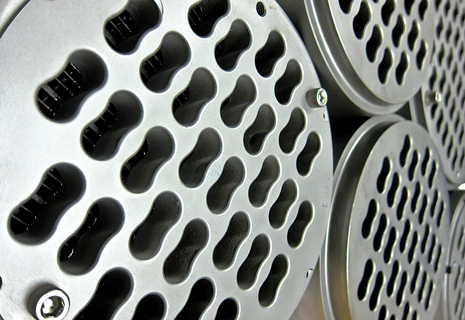 |
| The Zahroof Performance Valve (ZPV) is a drop-in replacement for existing valves. |
|
Natural gas production, gathering, transmission, storage, and pipeline distribution is dependent on reciprocating compressors. Valves are the component that most limit reciprocating compressors’ reliability, power consumption, operating cost and production/revenue. Studies have shown that more than 36% of all unscheduled compressor shutdowns are due to issues with valves; and more than 20% of the power used in pipeline transmission compressors is lost in the valves. Improvements in conventional valve design have plateaued over the past 50 years. Conventional valve (plate, poppet and ring) designs are decades old and have reached the limit of their functional potential, with only very minor improvements being made in design; substantiating the need for a disruptive new design that enables higher efficiency and reliability.
CURRENT SOLUTION
Due to the torturous flow path encountered by gases in conventional, reciprocating compressor valve designs, more than 20% of the power consumed by medium-speed compressors in transmission applications is lost in the valves, Fig. 1. The life and reliability of valves decrease with increasing speed, and with the presence of liquids and dirt in the gas stream.
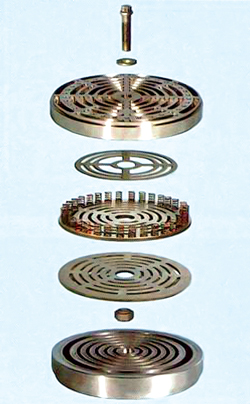 |
| Fig. 1. The image depicts a ported plate valve that has multiple moving components and a torturous flow path that results in reduced efficiency and reliability. |
|
As previously mentioned, more than 36% of all unscheduled compressor shutdowns are due to valves. Such shutdowns, which result in increased maintenance and downtime, result in huge losses. Valves have to be serviced periodically, due to wear of the seat and guard from impact, and the failure of the helical coil springs and the plastic sealing element. Servicing requires the replacement of the springs and sealing elements, and the precision machining of the metal seats and guards using special tools.
The presence of solids and liquids in the gas stream, as in shale gas production, accelerates failure by several orders of magnitude, with valves requiring servicing every five days in some cases. Service intervals for conventional valves range from one year, for clean gas applications, such as pipeline transmission, to an average of six weeks, for gas gathering applications.
Valves are expensive consumables, as they typically need to be completely replaced after two service intervals. The cost and time required to service, and replace, valves is considerable; however, the cost of downtime and loss of productivity is several magnitudes higher. Inventory costs are high as a range of fully assembled, expensive valves, and components must be stocked for different cylinders and operating conditions to reduce compressor downtime. Compressor manufacturers are forced to design low-speed compressors to improve the reliability, and efficiency, of their equipment, due to the inherent limitations of existing valve designs.
DISRUPTIVE TECHNOLOGY
The Zahroof Performance Valve (ZPV, Fig. 2.) is a disruptive technology that offers an improvement in the features that are critical to valve quality – efficiency, life, reliability, serviceability and cost of ownership. ZPVs are a drop-in replacement for existing valves. They are composed of stationary standard modules, each an independent straight-through-flow reed valve, captured between a seat and a carrier, with all the wear contained within the modules. The proven reed design improves reliability and doubles the duration between maintenance intervals. The reed design, combined with the straight flow path, makes the ZPV very tolerant to both liquids and solids in the gas stream, Fig. 3. This makes the ZPV ideally suited to shale gas applications, and it enables compressor OEMs to design smaller, higher speed compressors for a given application. The modules are of a standard size, independent of cylinder brand or application, and the valve, itself, can be easily serviced, on site, by the simple replacement of the modules. There is no requirement for machining or skilled labor.
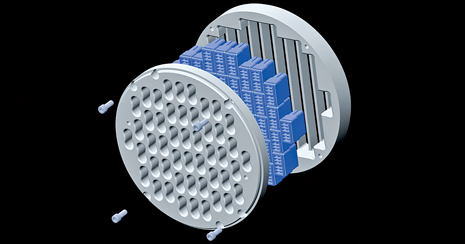 |
| Fig. 2. Exploded view of an 8-in. diameter Zahroof Performance Valve with 48 modules held between the valves seat and carrier. |
|
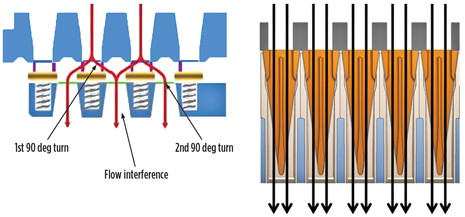 |
| Fig. 3. The first image, left, depicts the flow path encountered by gas flowing through a conventional valve. It includes several sharp turns in the flow path. The second image, right, represents the straight-through flow path of a Zahroof Performance Valve. |
|
The expensive, metal valve seat and carrier does not see any wear and would never need to be machined or replaced, unlike conventional valves, resulting in significant maintenance savings. The turn-around time for a ZPV valve is, on average, 5-10 minutes with unskilled labor, and it requires no special tools or machining at the compressor site. On the other hand, the turn-around time for traditional valves is 24-48 hours at a specialty machine shop outside the compressor site.
Users can stock standard modules in shoe boxes, compared to having to store racks of expensive valves and components of various sizes, thereby reducing inventory by more than 80%. The space savings and improved reliability are especially critical in offshore applications, or difficult-to-access locations.
Current modules and valves can handle 2,500-psi differential pressure across the valves, and a continuous operating temperature from -40°F to 500°F, at speeds from 300 to 3,600 rpm. These conditions represent approximately 90% of the market. The ZPVs are positioned as a drop-in replacement for all conventional valves; from low-speed poppet replacement to high-speed plate and ring valve replacement.
The ZPVs are offered in three material combinations, depending on the corrosive nature of the gas: N, M and X. These combinations feature increasing continuous temperature and chemical resistance capability. In addition, a proprietary advanced gas compressor simulation program, based on NIST real gas routines, uniquely enables the optimization of ZPVs for an application by accurately simulating the compressor operating with these valves, at these conditions. The program has the capability to simulate compressors with different types of valves, including plate, poppet, ring, and ZPV valves; unloaders; and to troubleshoot issues with the cylinder.
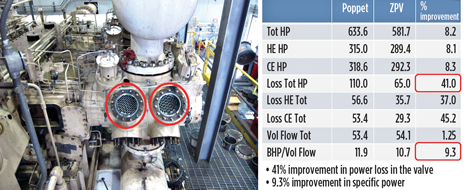 |
| Fig. 4. The image, left, depicts the installation of ZPV at a customer location. The table, right, represents the results measured at the compression station, which shows up to 41% improvement in valve losses. |
|
ZPVs were tested in a major compressor OEM R&D facility in natural gas and carbon dioxide, over a wide range of operating conditions. The power consumed by the ZPV ranged from 4-8% less than that consumed by the standard valves. ZPVs were also tested by one of the leading natural gas producers in North America, at two different compressor stations in the U.S., Fig. 4. The power reduction was measured, by the reliability group, to be 10% less than the most efficient conventional valve. The ZPV was subject to a torture test at 3,600 rpm and 450°F discharge temperature (the highest industrial compressor speed is 2,400 rpm, and the highest discharge temperature is 350°F) for 3.5 months. No wear was observed; however, the modules sealed better, as all the high spots on the sealing surface had been removed.
IMPROVED ECONOMICS
The ZPV valve delivers a 10% compressor power savings in a 1,000-rpm, 3,800-hp pipeline transmission compressor, which translates to $46,000 p.a. (at $2.5/Mcf) in energy savings, along with a 10% drop in emissions per compressor. Alternatively, the savings would enable a compressor to pump an additional $30 million of gas through a pipeline annually, with no change other than the valves. With 10-15 compressors per station, and/or a higher gas price (as seen in other parts of the world), the ZPV valve can, theoretically, enable $300-450 million in additional annual gas throughput through a gas pipeline. Apart from significantly higher revenues, EBIT, and energy savings; ZPV also leads to significant cost savings by reducing inventory, increasing maintenance intervals, longer life and higher reliability.
IMPROVED PERFORMANCE
The Zahroof Performance Valve (ZPV) is a drop-in replacement for existing valves for reciprocating gas compressors. It delivers 10% compressor power savings in pipeline transmission applications, increases reliability by a factor of two, is the simplest valve to service, and reduces inventory by at least 80%. It is a green technology and a revenue multiplier.
The introduction of ZPV not only brings disruptive improvement to valve designs but also would enable dramatic improvement in compressor designs, leading to massive improvement across all parameters.
ZPV has a wide range of applications, including the natural gas industry (gas production, gathering, transmission, storage, distribution, CNG, LNG), petrochemical industry, CNG/LNG for transportation, power, carbon dioxide sequestration, air compression, hydrogen, technical gases and refrigeration.
ZPVs can help customers reduce energy consumption, increase production, minimize operational costs and maximize profits. ZPVs offers a 20% improvement in valve efficiency, and a 25% increase in service interval. 
|
The author
ZAHROOF MOHAMED is the president and CEO of Zahroof Valves, Inc. (ZVI). Mr. Mohamed has over 20 years of experience in top engineering and R&D positions, and he has successfully brought several products from concept to market. Mr. Mohamed is the inventor of the ZPV and the founder of ZVI. Before ZVI, he was most recently Chief Engineer for Samsung Techwin. He set up and established their Center for Turbomachinery Design in Houston, established Samsung's centrifugal gas compressor product line, designed the HD and LD centrifugal compressors for LNG carriers, and oversaw engineering in Changwon, Korea. Prior to this, Mr. Mohamed worked with Cameron Compression Systems, York International and Atlas Copco. He holds an MS in mechanical engineering from Texas A&M University and a Diploma in International Management from IFL (Swedish Management Institute). |
|







